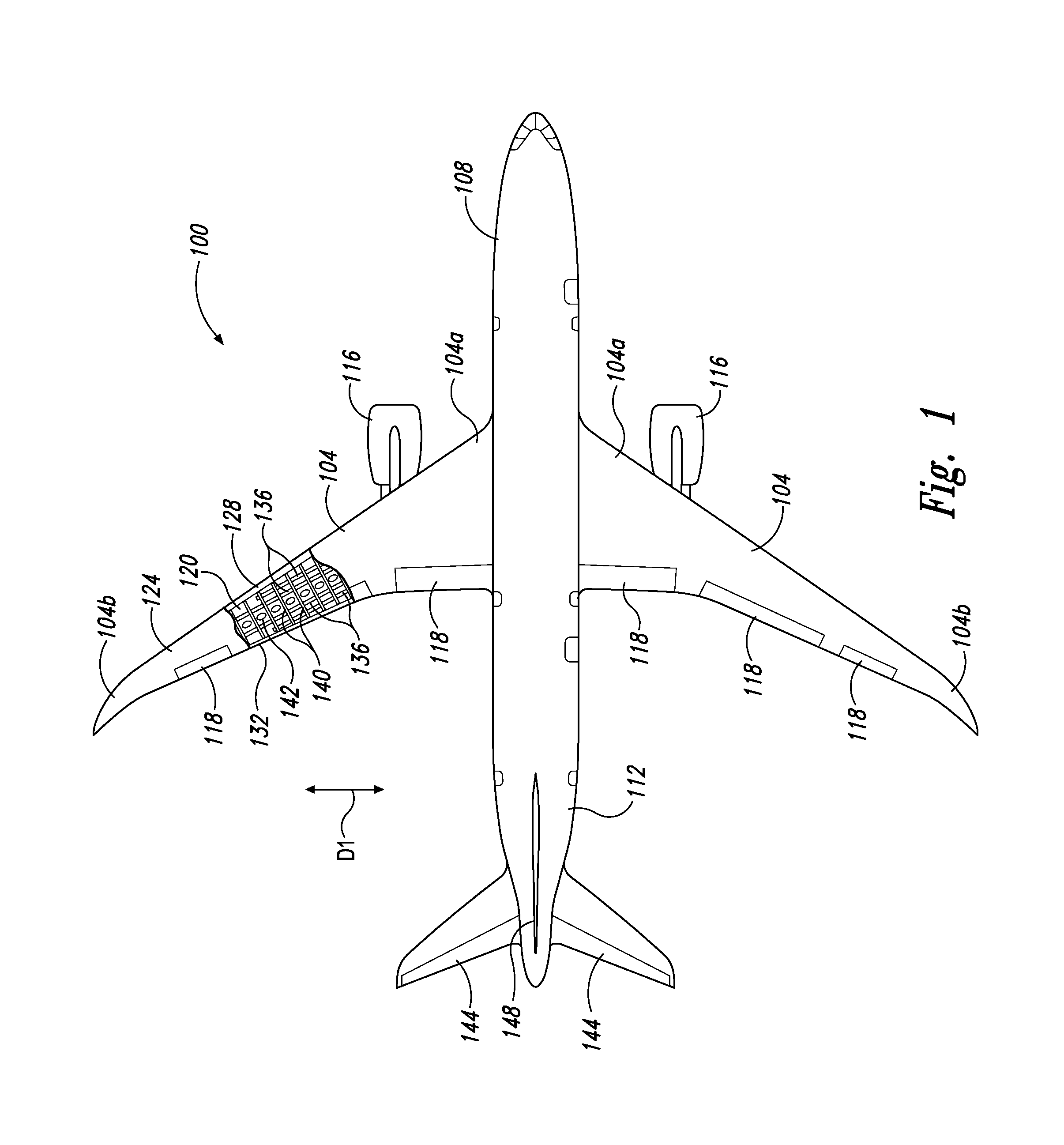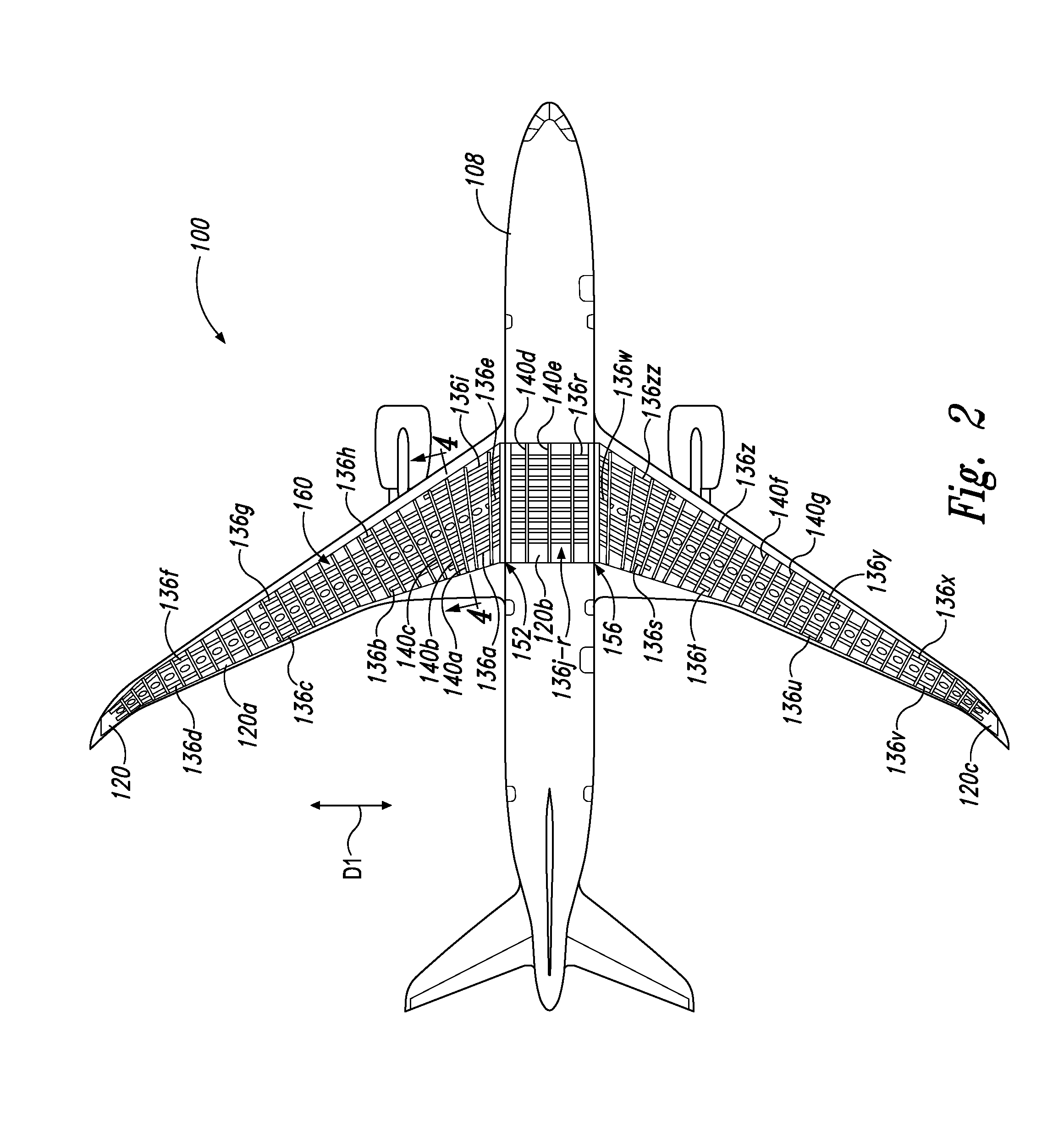Laminate composite wing structures
a composite wing and laminate technology, applied in sandwich constructions, transportation and packaging, spars/stringers, etc., can solve the problems of increased exterior vertical profile, reduced internal clearance, and difficulty in constructing i-shaped stringers or t-shaped stringers that are curved, and achieve the effect of stiffening the wing
- Summary
- Abstract
- Description
- Claims
- Application Information
AI Technical Summary
Benefits of technology
Problems solved by technology
Method used
Image
Examples
example 2
[0087]This example describes an illustrative one-piece wing embodiment, which may be alternatively included in aircraft 100; see FIGS. 8-11.
[0088]In this example, wing skin 120 may be continuous (or substantially continuous) between wing tips 104c, 104d of wing 104, as can be seen in FIGS. 8 and 9. Further, stringers 136 may include a plurality of stringers, such as stringers 800a-i, which may each be similar in structure to stringer 136g described above.
[0089]As can be seen, stringers 800a-i may each be curved and extend continuously from one of wings 104 to an adjacent wing 104 of aircraft 100. For example, stringers 800a-i may have one or more sweeping curvatures (e.g., in an aft-ward direction, as shown in FIGS. 8 and 11), and one or more dihedral curvatures (e.g., in an up-ward direction, as shown in FIGS. 9 and 10). Associated axes of the one or more sweeping curvatures may be substantially orthogonal to associated axes of the one or more dihedral curvatures. Such mutually ort...
example 3
[0095]This example describes a method for stiffening a wing; see FIG. 12. Aspects of components described herein may be utilized in the method steps described below. Where appropriate, reference may be made to previously described components and systems that may be used in carrying out each step. These references are for illustration, and are not intended to limit the possible ways of carrying out any particular step of the method.
[0096]FIG. 12 is a flow chart illustrating steps performed in an illustrative method, and may not recite the complete process. In particular, FIG. 12 depicts multiple steps of a method, generally indicated at 1200, which may be performed in conjunction with disclosed embodiments according to aspects of the present disclosure. Although various steps of method 1200 are described below and depicted in FIG. 12, the steps need not necessarily all be performed, and in some cases may be performed in a different order than the order shown.
[0097]For example, method...
example 4
[0101]This example describes a method of forming (or manufacturing) a tension panel, such as wing skin 120, with respective stringers, such as stringers 136 (e.g., stringers 136a-z, 136zz and / or stringers 800a-k) structurally joined thereto; see FIGS. 13-15.
[0102]As shown in FIG. 13, a plurality of plies of skin reinforcement material, generally indicated at 1300, may be stacked on a skin caul 1304. For example, plies 1304 may correspond to an uncured configuration of plies 502, which when cured may form lower wing skin 120. For example, plies 1304 may correspond to a plurality of generally planar carbon fiber pre-preg plies with various angular orientations. For example, plies 1304 may correspond to plies P1-P36 shown in Table 3 below, with ply P1 corresponding to the ply adjacent caul 1304, ply P36 being furthest from caul 1304, and plies P2-P35 being serially disposed there between.
TABLE 3PlyOrientationP145P290P3−45P40P545P60P7−45P80P945P100P11−45P1290P1345P140P15−45P160P1745P180...
PUM
 Login to View More
Login to View More Abstract
Description
Claims
Application Information
 Login to View More
Login to View More - R&D
- Intellectual Property
- Life Sciences
- Materials
- Tech Scout
- Unparalleled Data Quality
- Higher Quality Content
- 60% Fewer Hallucinations
Browse by: Latest US Patents, China's latest patents, Technical Efficacy Thesaurus, Application Domain, Technology Topic, Popular Technical Reports.
© 2025 PatSnap. All rights reserved.Legal|Privacy policy|Modern Slavery Act Transparency Statement|Sitemap|About US| Contact US: help@patsnap.com



